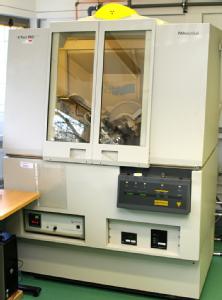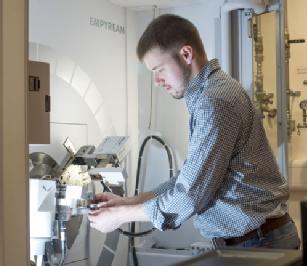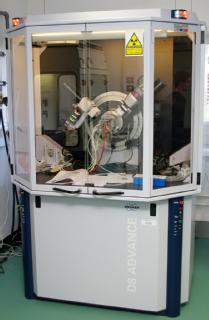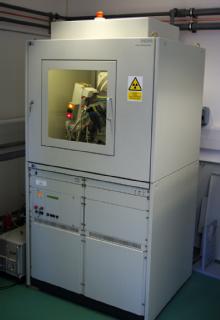Powder X-Ray Diffraction
X-ray diffraction (XRD) is a powerful technique for the study of powder and polycsprystalline materials. At its simplest, Powder XRD can be used for phase identification against a database of known patterns. At its most advanced, high-resolution powder XRD can be used to perform Rietveld refinement yielding the crystal symmetry and atomic positions.
The powder diffraction facility at Warwick is extremely well equipped for the study of a wide variety of powders, polycrystalline samples and ceramics. We have five diffractometers covering high-throughput, high-resolution, high-temperature, low-temperature and in-site reactions. This allows for both simple Phase-ID and more complicated and detailed studies to be undertaken.
 Panalytical X-Pert Pro MPD Kα1
Panalytical X-Pert Pro MPD Kα1
The Panalytical X-Pert Pro MPD is our flagship powder diffractometer, offering high-resolution and a large degree of experimental flexibility. Main applications include phase-ID of more complicated structures, refinement of structures via Rietveld refinement and non-ambient studies of phase-transitions.
In its standard configuration, the X'pert Pro MPD is equipped with a focussing Johanson monochromator on the incident beam optics. This gives very high-resolution pure Cu Kα1 radiation. However, it can also be easily changed into a more standard Bragg-Brentano geometry for higher intensity (at the cost of resolution). The solid-state PiXcel detector has an active length of ~3.2° 2θ and coupled with excellent signal to noise enables patterns for PhaseID to be obtained from certain samples in ~ 15 minutes.
There are 2 sample stages for room temperature applications, a reflection / transmission spinner stage for room temperature diffraction scans, a Z-translation stage for the study of thin-films or solid ceramics. For non-ambient experiments the Anton Paar HTK1200N spinner chamber is capable of achieving temperatures between 25°C and 1200°C in either air or a vacumn and is also equipped with a capillary spinner. Coupled with the high-resolution and fast detector, this allows detailed non-ambient experiments to be undertaken looking at phase-transitions and the formation of materials at high temperature.
 Panalytical Empyrean (Co target)
Panalytical Empyrean (Co target)
The state of the art Panalytical Empyrean is equipped with a Co target which, with a longer wavelength than the other Cu based systems, avoids the Fe fluorescence. This makes it hightly suited to the study of steel and other Fe based materials. It is setup in the standard Bragg-Brentano geometry with an Fe filter to suppress the Co Kβ wavelength. The solid-state PiXcel detector has an active length of ~3.2° 2θ and coupled with excellent signal to noise enables patterns for PhaseID to be obtained from certain samples in ~ 5 minutes. There are 2 sample stages for room temperature applications, a reflection / transmission spinner stage for room temperature diffraction scans, a Z-translation stage for the study of thin-films or solid ceramics.
Bruker D8 Advance
 The Bruker D8 Advance is optimised for high-throughput in-situ gas reaction measurements. For maximum intensity and throughput, it is equipped with unmonochromated Cu radiation and a Ni filtered VÅNTEC-1 detector with an active length of 12° 2θ. The sample is held in an Anton Paar XRK 900 reaction chamber, a chemical reaction cell for studies in the presence of reactive gases (oxidising and reducing) at up to 10 bar.
The Bruker D8 Advance is optimised for high-throughput in-situ gas reaction measurements. For maximum intensity and throughput, it is equipped with unmonochromated Cu radiation and a Ni filtered VÅNTEC-1 detector with an active length of 12° 2θ. The sample is held in an Anton Paar XRK 900 reaction chamber, a chemical reaction cell for studies in the presence of reactive gases (oxidising and reducing) at up to 10 bar.
This general purpose Cu Kα X-ray powder diffractometer is equipped with standard Bragg-Brentano geometry and a diffracted beam graphite monochromator. It is used primarily for standard phase identification.
The Bruker D5005 is equipped with an Oxford Cryosystems PheniX low temperature stage allowing studies to be carried out at down to 12K.

